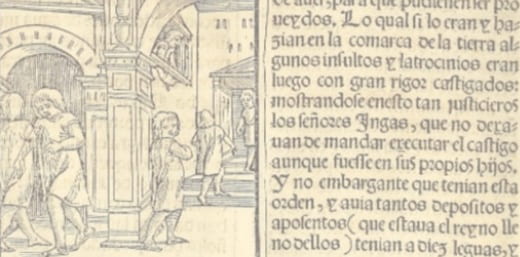In December 2021, the Center for the Study of Colonial America (CEAC) from the Universidad Autónoma de Barcelona released its annual peer-reviewed journal Nuevas de Indias 6 (2021), which included, for the first time, a monographic section (coordinated by Paul Firbas) titled “Textuality and Visual Culture of the Colonial Period.” This publication (in Spanish), comprising five articles and an introductory essay, is the product of the research behind the symposium held at Stony Brook University in March 2020, just days before the pandemic forced a closure of university campuses worldwide.
The introductory essay, by Paul Firbas, goes back to ideas discussed at the symposium on textual scholarship in the digital age, opening the conversation to media history and material culture in colonial settings. This short essay explores the dynamics between printed words and images in Pedro Cieza de León’s Crónica del Perú first editions (published in 1553 and 1554) and how today’s digital tools and platforms could improve our research and studies of such textuality.
The five articles included in the monographic section deal with extensive archival material and digital reproductions that facilitated the identification or construction of their objects of study. Each study is connected to a network of textual and iconic relationships involving multiple agents. There is no traditional image of an author in these objects, either because ecclesiastical and gender hierarchies discouraged this role for women; because the nature of the artistic object in study was part of a workshop for which no documentation is preserved; or because the object itself is a symbolic network woven around a historical event –such as the inauguration of a viceroy— preserved in various testimonies and formats that dialogue with each other.
Judith Farré’s study, entitled “The entrance in Puebla of the Marquis de las Amarillas (1755), Iconography and Sermon Políticogratulatorio,” focuses on the historical entrance of the new viceroy in New Spain and on the various coded forms, mainly visual, of representing power. In the article “Wind and Fortune in the Representation of the France Antarctique,” Fernando Loffredo studies the iconographic tradition of the windy landscape in two wooden reliefs made in the middle of the 16th century in Rouen (Normandy), which represent naked indigenous people working on the extraction and trade of Brazilian wood. In the study entitled “‘So similar the portrait.’ On the Life of venerable sor María Anna Águeda de San Ignacio and the visual tradition of her time,” Beatriz Ferrús Antón analyzes the text signed by the Jesuit Joseph Bellido, published in Mexico in 1758, on the exemplary life of the founder and prioress of the convent of the Dominicas Recoletas de Santa Rosa de Puebla. The article confronts the biography with textual and iconographic traditions of religious exemplary lives, whose main model was then the criolla Santa Rosa de Lima, canonized in 1671. The article by Esperanza López Parada, “Compensated Passions, Public Vices and Disruptive Images in the Reception of a Viceroy,” studies the complex visual representations of mythological scenes used to criticize the historical entrance in the city of Potosí of Archbishop Diego Morcillo Rubio de Auñón, as viceroy, on his journey from La Plata to Lima. Finally, José A. Rodríguez Garrido’s article on “The Manuscripts of Flor de Academias: from the Literary Act to the Illustrated Book,” studies the diverse manuscripts and editorial history of the poetic texts produced by the Academy that directed Viceroy Castelldosrius in Lima between 1709 and 1710.
The five articles gathered in the monographic section of Nuevas de Indias deal mainly with the viceregal elites of Mexico and Lima, their political and cultural exchanges, and their fluent communications with the metropolitan court; but also, with a real (and desired) transatlantic France in America, richly envisioned through classical and Renaissance traditions. The viceregal symbolic production orchestrated by the elites –especially in the spectacular urban culture of public celebrations– integrated a diversity of nations and local communities, opening spaces for heterogeneous ways of creating meaning and textuality in the Indies.


